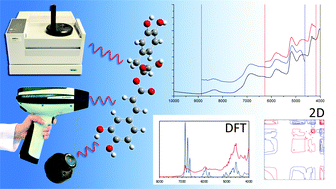Critical evaluation of spectral information of benchtop vs. portable near-infrared spectrometers: quantum chemistry and two-dimensional correlation spectroscopy for a better understanding of PLS regression models of the rosmarinic acid content in Rosmarini folium†
Abstract
In the present work the performances of one benchtop and two different types of miniaturized near-infrared (NIR)-spectrometers were tested and compared for the first time by the determination of the rosmarinic acid (RA) content of dried and powdered Rosmarini folium. The recorded NIR spectra were utilized in hyphenation with multivariate data analysis (MVA) to calculate Partial Least Squares (PLS) regression models. Quality parameters obtained from Cross Validation (CV) revealed that the benchtop NIR-device “NIRFlex N-500 FT-NIR spectrometer” achieved the best result with a R2 of 0.91 and a RPD of 3.27. The miniaturized NIR-device “MicroNIR 2200 spectrometer” showed a satisfying calibration quality with a R2 of 0.84 and a RPD of 2.46. The miniaturized NIR-device “ThermoScientific microPHAZIR” with a R2 of 0.73 and a RPD of 1.88 was less precise and needs to be improved. The measured spectra of the different devices were additionally investigated by two-dimensional correlation spectroscopy (2D-COS) analysis, which supported the performed PLS regression models as well as identified the discrepancies for microPHAZIR and MicroNIR 2200 compared to NIRFlex N-500. With the aim to obtain a better understanding of the factors which determine the analyzed PLS regression models, the NIR spectrum of RA was reproduced through application of fully anharmonic quantum chemical calculation. A good agreement between the experimental and theoretical NIR spectra and detailed band assignments of RA were obtained in the 8000–4000 cm−1 wavenumber region. Subsequently, this enabled us to attribute the main influences in the regression coefficients plots. This study demonstrated that the performance of NIR spectroscopy with benchtop and miniaturized devices as a fast and non-invasive technique is able to replace time- and resource-consuming analytical tools. Referring to the developed application of the RA content quantification this work is especially interesting for the continuous growing phytopharmaceutical industry and its quality control. The results reveal the importance of monitoring the performances of available NIR-spectrometers in every analytical area.


 Please wait while we load your content...
Please wait while we load your content...